您好,登錄后才能下訂單哦!
您好,登錄后才能下訂單哦!
這篇文章將為大家詳細講解有關Springboot+Flowable如何升級改造OA系統,文章內容質量較高,因此小編分享給大家做個參考,希望大家閱讀完這篇文章后對相關知識有一定的了解。
公司內部的OA系統最近要升級改造,由于人手不夠就把我借調過去了,但說真的我還沒做過這方面的功能,第一次接觸工作流的開發,還是有點好奇是個怎樣的流程。
項目主要用 Springboot + Flowable 重構原有的工作流程,Flowable 是個用 Java語言寫的輕量級工作流引擎,上手比較簡單開發效率也挺高的,一起學習下這個框架。
官方地址:https://www.flowable.org/docs/userguide/index.html,分享的只是簡單應用,深入研究還得看官方文檔。
<!--flowable工作流依賴--> <dependency> <groupId>org.flowable</groupId> <artifactId>flowable-spring-boot-starter</artifactId> <version>6.3.0</version> </dependency> <dependency> <groupId>org.springframework.boot</groupId> <artifactId>spring-boot-starter-jdbc</artifactId> </dependency> <dependency> <groupId>org.springframework.boot</groupId> <artifactId>spring-boot-starter-web</artifactId> </dependency> <dependency> <groupId>org.mybatis.spring.boot</groupId> <artifactId>mybatis-spring-boot-starter</artifactId> <version>1.3.2</version> </dependency> <dependency> <groupId>mysql</groupId> <artifactId>mysql-connector-java</artifactId> <scope>runtime</scope> </dependency>
工作流開發的核心是任務流程的設計,Flowable 官方建議采用業界標準BPMN2.0的 XML來描述需要定義的工作流。
我們需要在 resource 目錄下創建 processes路徑,存放相關的 XML流程配置文件。Flowable 框架會默認加載此目錄下的工作流文件并解析 XML,并將解析后的流程配置信息持久化到數據庫。
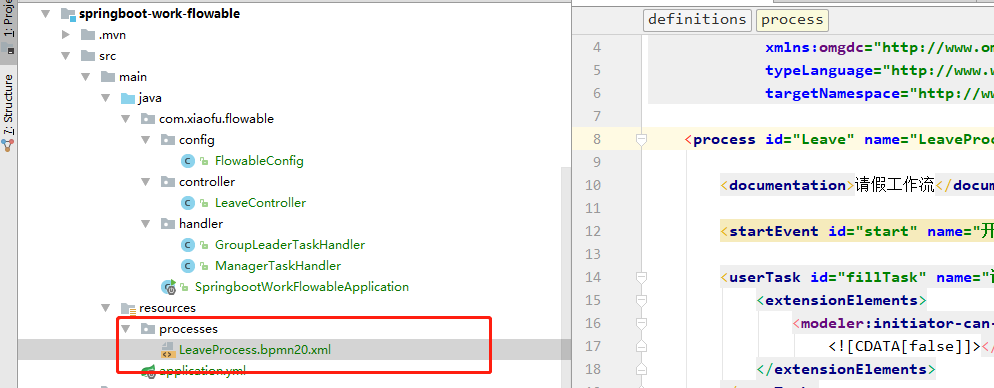
Flowable 是依賴于數據庫的,但它并不需要我們手動的創建表,而是在程序第一次啟動時,自動的向MySQL 中創建它所需要的一系列表。
spring: datasource: url: jdbc:mysql://47.93.6.5:3306/order?serverTimezone=UTC username: root password: 123455

看到項目啟動成功一共生成了60個表,數量還是比較多的,建議使用專門的數據庫存在這些工作流表。
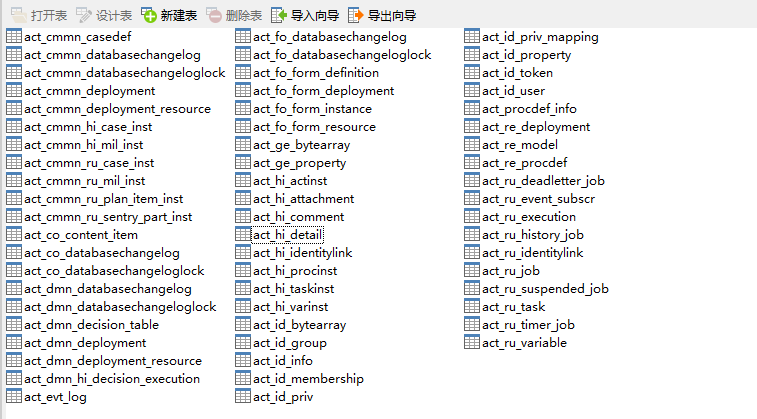
舉個栗子:假如一個請假流程,需要經理審核通過,請假才能生效,如果他駁回流程結束。

接下來我們用 XML 翻譯下上邊的請假流程圖,整體非常簡單只要夠細心就行了,一起看看每個標簽都是什么含義。
<?xml version="1.0" encoding="UTF-8"?>
<definitions xmlns="http://www.omg.org/spec/BPMN/20100524/MODEL" xmlns:xsi="http://www.w3.org/2001/XMLSchema-instance"
xmlns:flowable="http://flowable.org/bpmn" xmlns:bpmndi="http://www.omg.org/spec/BPMN/20100524/DI"
xmlns:omgdc="http://www.omg.org/spec/DD/20100524/DC" xmlns:omgdi="http://www.omg.org/spec/DD/20100524/DI"
typeLanguage="http://www.w3.org/2001/XMLSchema" expressionLanguage="http://www.w3.org/1999/XPath"
targetNamespace="http://www.flowable.org/processdef">
<process id="Leave" name="LeaveProcess" isExecutable="true">
<userTask id="leaveTask" name="請假" flowable:assignee="${leaveTask}"/>
<userTask id="managerTask" name="經理審核"/>
<exclusiveGateway id="managerJudgeTask"/>
<endEvent id="endLeave" name="結束"/>
<startEvent id="startLeave" name="開始"/>
<sequenceFlow id="modeFlow" sourceRef="leaveTask" targetRef="managerTask"/>
<sequenceFlow id="flowStart" sourceRef="startLeave" targetRef="leaveTask"/>
<sequenceFlow id="jugdeFlow" sourceRef="managerTask" targetRef="managerJudgeTask"/>
<endEvent id="endLeave2"/>
<sequenceFlow id="flowEnd" name="通過" sourceRef="managerJudgeTask" targetRef="endLeave">
<conditionExpression xsi:type="tFormalExpression">
<![CDATA[${checkResult=='通過'}]]>
</conditionExpression>
</sequenceFlow>
<sequenceFlow id="rejectFlow" name="駁回" sourceRef="managerJudgeTask"
targetRef="endLeave2">
<conditionExpression xsi:type="tFormalExpression">
<![CDATA[${checkResult=='駁回'}]]>
</conditionExpression>
</sequenceFlow>
</process>
<bpmndi:BPMNDiagram id="BPMNDiagram_process">
<bpmndi:BPMNPlane bpmnElement="Leave" id="BPMNPlane_process">
<bpmndi:BPMNShape bpmnElement="leaveTask" id="BPMNShape_leaveTask">
<omgdc:Bounds height="79.99999999999999" width="100.0" x="304.60807973558974" y="122.00000000000001"/>
</bpmndi:BPMNShape>
<bpmndi:BPMNShape bpmnElement="managerTask" id="BPMNShape_managerTask">
<omgdc:Bounds height="80.0" width="100.0" x="465.0" y="122.0"/>
</bpmndi:BPMNShape>
<bpmndi:BPMNShape bpmnElement="managerJudgeTask" id="BPMNShape_managerJudgeTask">
<omgdc:Bounds height="40.0" width="40.0" x="611.5" y="142.0"/>
</bpmndi:BPMNShape>
<bpmndi:BPMNShape bpmnElement="endLeave" id="BPMNShape_endLeave">
<omgdc:Bounds height="28.0" width="28.0" x="696.5" y="148.0"/>
</bpmndi:BPMNShape>
<bpmndi:BPMNShape bpmnElement="startLeave" id="BPMNShape_startLeave">
<omgdc:Bounds height="30.0" width="30.0" x="213.2256558149128" y="147.0"/>
</bpmndi:BPMNShape>
<bpmndi:BPMNShape bpmnElement="endLeave2"
id="BPMNShape_endLeave2">
<omgdc:Bounds height="28.0" width="28.0" x="617.5" y="73.32098285753572"/>
</bpmndi:BPMNShape>
<bpmndi:BPMNEdge bpmnElement="flowEnd" id="BPMNEdge_flowEnd">
<omgdi:waypoint x="651.1217948717949" y="162.37820512820514"/>
<omgdi:waypoint x="696.5002839785394" y="162.0891701657418"/>
</bpmndi:BPMNEdge>
<bpmndi:BPMNEdge bpmnElement="rejectFlow" id="BPMNEdge_rejectFlow">
<omgdi:waypoint x="631.866093577786" y="142.36609357778607" />
<omgdi:waypoint x="631.5931090276993" y="101.32067323657485" />
</bpmndi:BPMNEdge>
<bpmndi:BPMNEdge bpmnElement="modeFlow" id="BPMNEdge_modeFlow">
<omgdi:waypoint x="404.60807973558974" y="162.0" />
<omgdi:waypoint x="465.0" y="162.0" />
</bpmndi:BPMNEdge>
<bpmndi:BPMNEdge bpmnElement="flowStart" id="BPMNEdge_flowStart">
<omgdi:waypoint x="243.2256558149128" y="162.0" />
<omgdi:waypoint x="304.60807973558974" y="162.0" />
</bpmndi:BPMNEdge>
<bpmndi:BPMNEdge bpmnElement="jugdeFlow" id="BPMNEdge_jugdeFlow">
<omgdi:waypoint x="565.0" y="162.21367521367523" />
<omgdi:waypoint x="611.9141630901288" y="162.41416309012877" />
</bpmndi:BPMNEdge>
</bpmndi:BPMNPlane>
</bpmndi:BPMNDiagram>
</definitions>其實就是把流程圖的各種線條邏輯,用不同的XML標簽描繪出來了。
<process> : 表示一個完整的工作流
<documentation> : 對工作流的描述
<startEvent> : 工作流中起點位置(開始)
<endEvent > : 工作流中結束位置(結束)
<userTask> : 代表一個任務審核節點(組長、經理等角色)
<exclusiveGateway> : 邏輯判斷節點,相當于流程圖中的菱形框
<sequenceFlow> :鏈接各個節點的線條,sourceRef 屬性表示線的起始節點,targetRef 屬性表示線指向的節點。
上邊這一大坨XML是不是看著超級麻煩,要是有自動生成工具就好了,我發現IDEA自帶設計工具,但實在是太難用了。 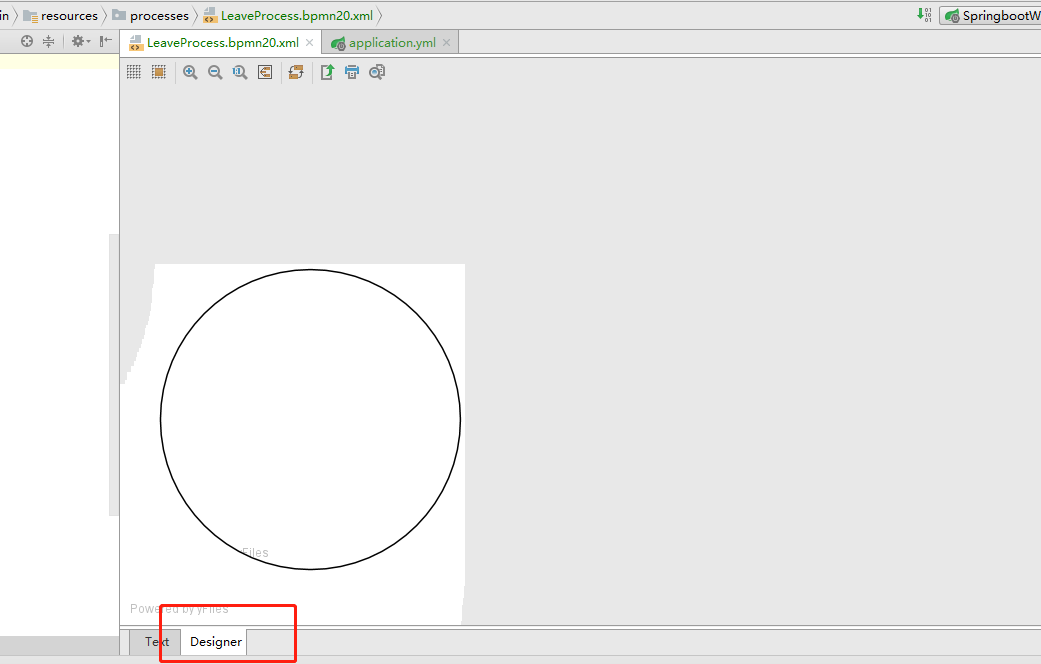
作為一個面向百度編程的程序員,別的不行上網找答案的能力還是可以的,既然我都覺得寫XML麻煩,那么想來官方肯定也想到了,說不定有現成的工具,逛了一圈官網https://www.flowable.org/downloads.html ,居然真的找到了。
github下載地址:https://github.com/flowable/flowable-engine/releases/download/flowable-6.4.0/flowable-6.4.0.zip,下載速度那是相當感人,而且這個工具需要自己安裝.......
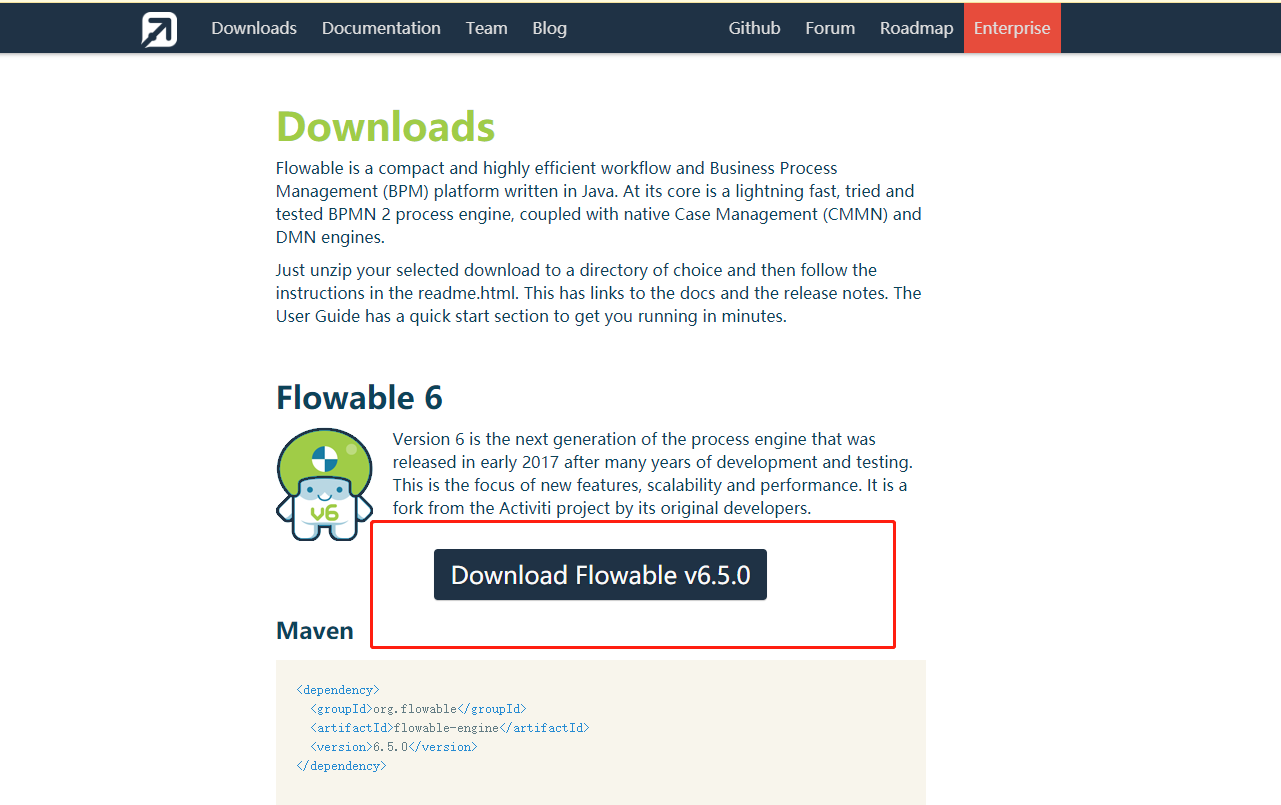 又找了個在線編輯的工具: http://www.learun.cn:8090/home_online.htm,各種折騰~,設計完流程后,直接復制自動生成的代碼即可。
又找了個在線編輯的工具: http://www.learun.cn:8090/home_online.htm,各種折騰~,設計完流程后,直接復制自動生成的代碼即可。 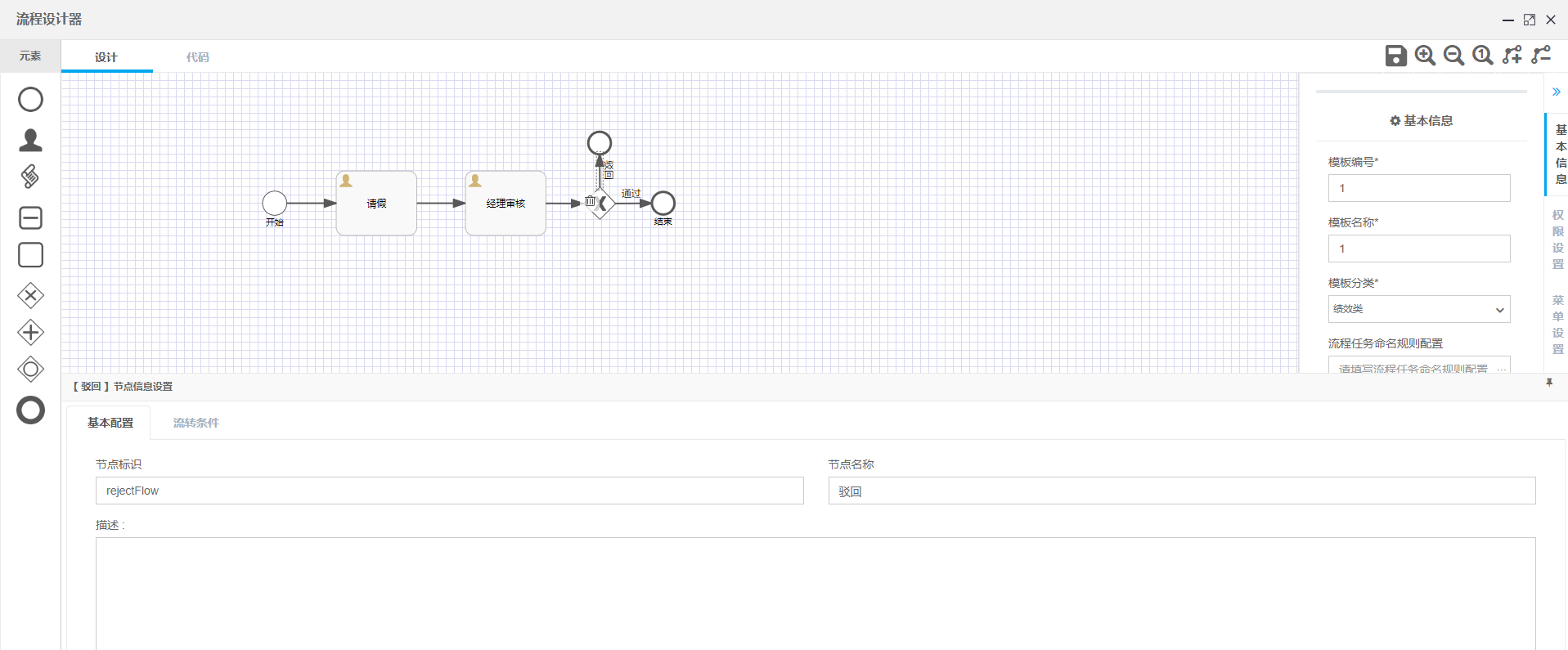
流程設計完后剩下的就是對工作流的審批和生成流程圖。
首先啟動一個請假的流程,以員工ID staffId 作為唯一標識,XML文件中會接收變量 leaveTask,Flowable內部會進行數據庫持久化,并返回一個流程Id processId ,用它可以查詢工作流的整體情況,任務Id task為員工具體的請假任務。
注意:一個請假流程 processId中可以包含多個請假任務 taskId。
/**
* @author xiaofu
* @description 啟動流程
* @date 2020/8/26 17:36
*/
@RequestMapping(value = "startLeaveProcess")
@ResponseBody
public String startLeaveProcess(String staffId) {
HashMap<String, Object> map = new HashMap<>();
map.put("leaveTask", staffId);
ProcessInstance processInstance = runtimeService.startProcessInstanceByKey("Leave", map);
StringBuilder sb = new StringBuilder();
sb.append("創建請假流程 processId:" + processInstance.getId());
List<Task> tasks = taskService.createTaskQuery().taskAssignee(staffId).orderByTaskCreateTime().desc().list();
for (Task task : tasks) {
sb.append("任務taskId:" + task.getId());
}
return sb.toString();
}用啟動流程時返回的 processId 看一下一下當前的流程圖
http://localhost:4000/leave/createProcessDiagramPic?processId=37513

接下來將請假申請進行駁回 ,傳入相應的 taskId 后執行駁回,再看看整個工作流的效果。
http://localhost:4000/leave/rejectTask?taskId=10086
/**
* @param taskId
* @author xinzhifu
* @description 駁回
* @date 2020/8/27 14:30
*/
@ResponseBody
@RequestMapping(value = "rejectTask")
public String rejectTask(String taskId) {
HashMap<String, Object> map = new HashMap<>();
map.put("checkResult", "駁回");
taskService.complete(taskId, map);
return "申請審核駁回~";
}看到整個請假流程在經理審核這成功阻斷了。
http://localhost:4000/leave/createProcessDiagramPic?processId=37513

開發工作流一般多用在OA系統等傳統項目中,我也是第一次嘗試做此類功能,收獲還是蠻多的,技術棧又壓進了一個知識點。
關于Springboot+Flowable如何升級改造OA系統就分享到這里了,希望以上內容可以對大家有一定的幫助,可以學到更多知識。如果覺得文章不錯,可以把它分享出去讓更多的人看到。
免責聲明:本站發布的內容(圖片、視頻和文字)以原創、轉載和分享為主,文章觀點不代表本網站立場,如果涉及侵權請聯系站長郵箱:is@yisu.com進行舉報,并提供相關證據,一經查實,將立刻刪除涉嫌侵權內容。